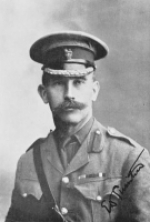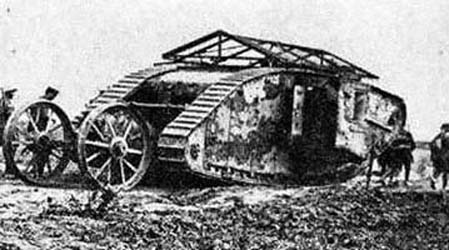Ernest Dunlop Swinton
Le Général-Major Sir Ernest Dunlop Swinton est un officier de sa majesté né en 1868 à Bangalore (Inde), auteur de plusieurs ouvrages militaires mais surtout connu comme le père des chars en Grande-Bretagne (et forcèment des premiers chars au monde) durant la 1re Guerre Mondiale. C'est lui également qui popularisera le terme de "no-mans land". Il suivra les cours des 'University College School, Rugby School, Cheltenham College, Blackheath Proprietary School, Royal Military Academy, Woolwich. Il entra comme officier dans le Corps of Royal Engineers in 1888 et effectuera son service en Inde où il sera promu Lieutenant en 1891.
The Major General Sir Ernest Dunlop Swinton is an officer of his majesty born in 1868 in Bangalore (India), author of several military books but especially known like the father of the tanks in Great Britain (and forcing of the first tanks in the world) during the 1st World war. It(s him also which will popularize the term of " No-mans land". He will follow the courses of the 'University School College, School Rugby, Cheltenham College, Blackheath Proprietary School, Royal Military Academy, Woolwich. He entered as officer the Corps of Royal Engineers in 1888 and will realize its service in India where he will be promoted Lieutenant in 1891.
 |
src: Library
Thing
|
Il sera récompensé du Distinguished Service Order durant la seconde guerre des Boers en Afrique du Sud. Après cette guerre, il réalisa un livre sur la tactique au sein des petites unités (The Defense of Duffer's Drift). Avant la première guerre mondiale, il fut officier d'état-major et historien officiel de la guerre russo-japonaise. Au début de la guerre, le ministre de la guerre, Lord Kitchner, nomma Swinton comme correspondant de guerre officiel sur le front occidental en Europe. Swinton n'avait pas accès au front comme le reste de la Presse et ses rapports étaient également soumus à une forte censure militaire.
He will be rewarded for Distinguished Service Order during the second war of Boers in South Africa. After this war, he wrote a book on the tactics within the small units (The Defense off Duffer' S Drift). Before the First World War, he was officer of staff and official historian of the Russian-Japanese war. At the beginning of the war, the Minister of war, Lord Kitchner, named Swinton as official war correspondent on the Western front in Europe. Swinton did not have as access to the front like the remainder of the Press and its reports were also soumus with a strong military censure.
 |
Mark I Male |
src: Great
Britain Tanks
|
 |
Mark IV Female |
src: Great
Britain Tanks
|
C'est le 19 octobre 1914 en conduisant sa voiture sur une route française que Swinton eut l'idée du char comme il le raconte dans son livre Eyewitness. Ceci après avoir reçu en juillet une lettre de son ami sud-africain, l'ingénieur Hugh Merrit qui pensait que des tracteurs blindés pouvaient être très utiles. En novembre 1914, le Major Swinton suggéra cette idée de véhicules blindés chenillés aux autorités militaires. Al la même époque, Swinton largua depuis un avion un papier de propagande au dessus des lignes allemandes, réalisé avec ses propres moyens. L'idée de véhicule blindé fut ignoré par l'armée britannique mais le colonel Maurice Hankey transmettra à la fin de l'année l'idée à Winston Churchill et à l'Amirauté. Un comité de cuirassés terrestres fut mis en place.
It'is on October 19, 1914 by driving its car on a French road that Swinton had idea of the tank as he tells it in his Eyewitness book. This after having received in July a letter of his South-African friend, the engineer Hugh Merrit which thought that armored tractors could be very useful. In November 1914, Major Swinton suggested this idea of tracked armored vehicles to the military authorities. Al the same time, Swinton released since a plane a paper of propaganda on the German lines, realized with its own means. The idea of armored vehicle was ignored by British army but colonel Maurice Hankey will transmit to the end of the year the idea to Winston Churchill and Admiralty. A committee of landships was created.
 |
Mark V Male |
src: Wikipédia |
En 1916, il est promu Lieutenant-Colonel et responsable de la formation et de l'entraînement de la première unité de char. Swinton établira les instructions tactiques pour les blindés. Sur le plan technique, les vrais inventeurs du char (Little Willie) furent Sir William Tritton (directeur-manager de William Foster & Co. Ltd. of Lincoln) et le Major Walter Gordon Wilson (Naval Air Service), comme le précisa la Royal Commission on Awards to Inventors. Swinton ne fut jamais autorisé à diriger une unité au combat à cause de son manque d'expérience du combat. En 1919, il termina sa carrière en tant que Général-Major. Ensuite il fut employé au département de l'aviation civile, au ministère de l'Air. Il fut nommé directeur chez Citroën en 1922. Il fut ensuite professeur d'histoire militaire à l'Université d'Oxford (1925-1939). A 66 ans, Swinton fut promu Colonel Commandant du Royal Tank Corps (1934-1938). Ernest Swinton décéda en 1951.
In 1916, it is promoted Lieutenant-Colonel and person in charge of the formation and training of the first unit of tank. Swinton will establish the tactical instructions for the armoured tanks. On the technical plan, truths inventors of the tank (Little Willie) were Sir William Tritton (director-manager of William Foster & Co. Ltd. of Lincoln) and Major Walter Gordon Wilson (Naval Air Service), as specified it Royal the Commission on Awards to Inventors. Swinton was never authorized to direct a unit to the combat because of its lack of experiment in combat. In 1919, he finished its military career as Major General. Then it was employed at the department of civil aviation, at the Air Ministry. It was named director at Citroen in 1922. He was then professor of military history at the University of Oxford (1925-1939). At 66 years, Swinton was promoted Colonel Commander of the Royal Tank Corps (1934-1938). Ernest Swinton died in 1951.
 |
Medium A Whippet
|
src: Great
Britain Tanks
|